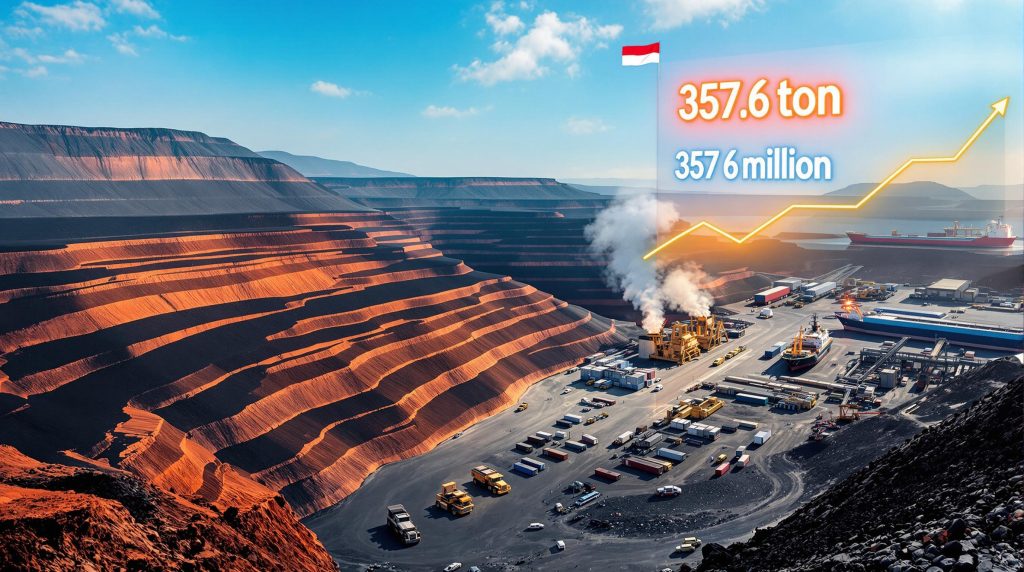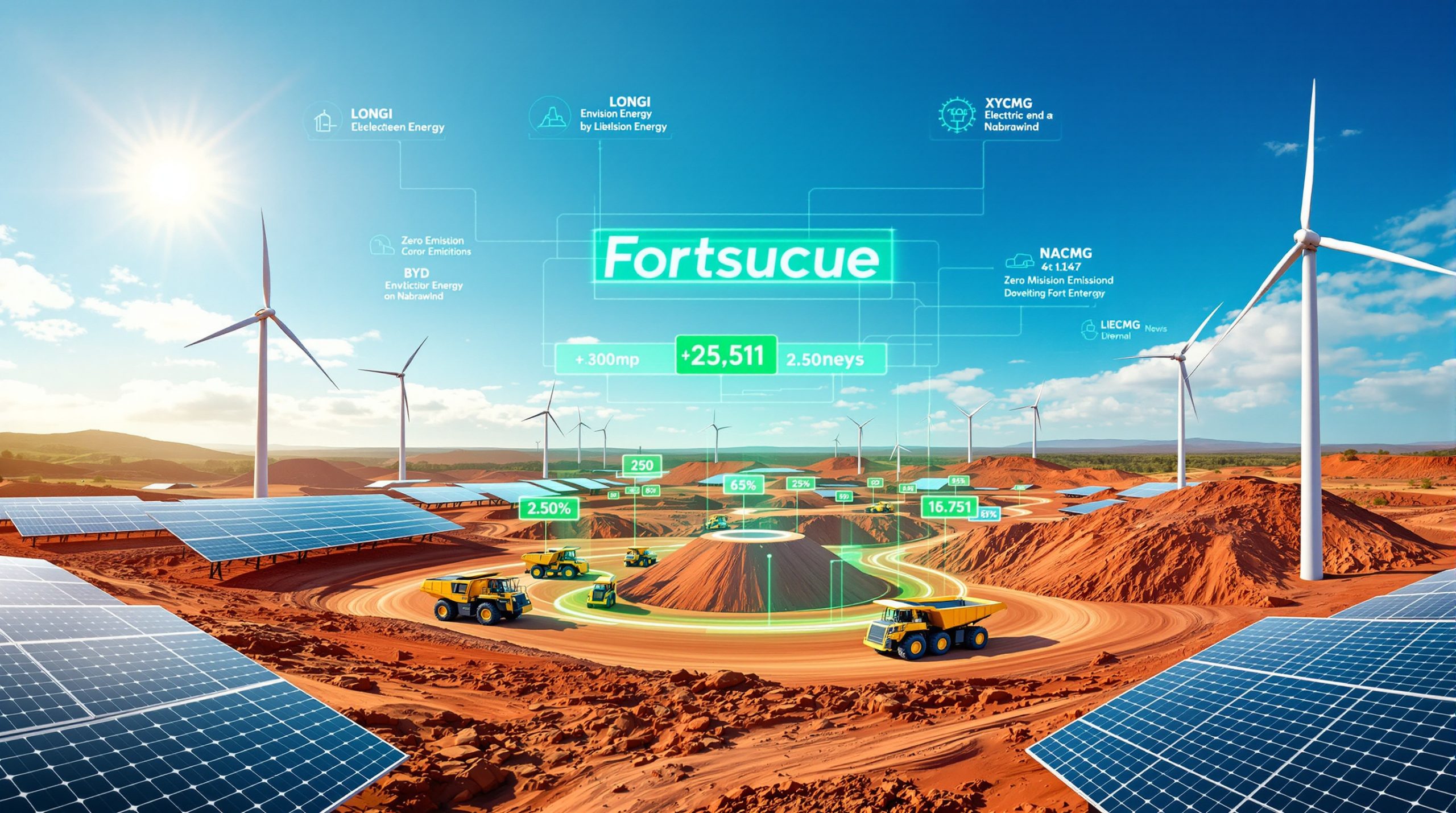Indonesia's Coal Production Evolution: A Decade of Growth and Market Leadership
Indonesia has cemented its position as one of the world's leading top coal producers with output volumes that continue to shape global energy markets. The country's coal industry has demonstrated remarkable resilience despite various international market fluctuations, environmental pressures, and regulatory changes.
First Half 2025 Production Performance
Indonesia produced 357.6 million metric tons of coal during the first half of 2025, according to the latest data from the Energy and Mineral Resources Ministry. This substantial output represents approximately 48% of the government's annual production target of 739.7 million tons for the year.
The impressive first-half performance puts Indonesia on track to potentially exceed its annual target, continuing a pattern observed in recent years. This consistent output underscores the country's critical role in maintaining global coal supply stability.
Export Performance in 2025
During the January-June 2025 period, Indonesia exported 238 million tons of coal, representing approximately 67% of its total production. This export-focused approach highlights Indonesia's pivotal role in the global coal supply chain and its importance to energy security across numerous Asian markets.
The export ratio demonstrates Indonesia's continued commitment to serving international markets while simultaneously ensuring sufficient supply for domestic requirements. This balancing act represents one of the key strategic challenges for policymakers in the sector.
Historical Production Trends
Indonesia has consistently exceeded government production targets in recent years:
- 2024: Actual production reached 836 million tons, significantly surpassing the government target of 710 million tons by approximately 18%
- 2023: Similar patterns of production exceeding targets were observed, reflecting robust industry capacity
- 2022: Despite global energy market disruptions, Indonesia maintained strong production levels
This pattern of exceeding targets reflects both strong market demand and the industry's substantial production capacity. It also highlights the effectiveness of Indonesia's mining sector in responding to market signals despite regulatory adjustments.
What Factors Drive Indonesia's Coal Export Market?
Indonesia's position as a major coal exporter is influenced by several key factors that shape its market dynamics and strategic importance in global energy supply chains.
Geographic Advantage
Indonesia's strategic location provides excellent access to major Asian markets with high coal demand:
- China: The world's largest coal consumer, with ongoing demand despite carbon reduction goals
- India: A rapidly growing energy market with increasing coal imports to fuel economic expansion
- Japan and South Korea: Developed economies with significant coal imports for power generation
- Southeast Asian neighbors: Emerging economies with growing energy requirements
The proximity to these key markets translates to reduced shipping times and transportation costs, giving Indonesian exporters a competitive edge against more distant suppliers.
Quality and Cost Advantages
Indonesian coal offers specific characteristics that make it attractive to international buyers:
- Varied calorific values: Ranging typically from 3,800 to 5,500 kcal/kg, suitable for different power generation needs
- Low ash content: Generally between 5-15%, reducing waste disposal requirements
- Low to moderate sulfur content: Usually below 1%, helping meet emissions standards in importing countries
- Competitive production costs: Among the lowest globally due to favorable mining conditions
- Open-pit mining accessibility: Reducing extraction costs compared to underground mining in some competing nations
These quality attributes make Indonesian coal particularly suitable for blending purposes, allowing power plants to optimize their fuel mix for both cost and environmental compliance.
Export Infrastructure Development
The country has developed substantial export infrastructure to facilitate coal shipments:
- Major coal terminals: Facilities like Balikpapan and Samarinda in East Kalimantan
- Specialized coal ports: Purpose-built loading facilities with high throughput capacity
- River transport systems: Extensive barge networks connecting inland mines to coastal export facilities
- Efficient logistics networks: Integrated transportation systems designed specifically for coal movement
This logistics infrastructure allows Indonesian producers to move large volumes efficiently from mine to market, further enhancing the country's competitive position in global coal trade.
What Challenges Does Indonesia's Coal Industry Face?
Despite its strong production and export performance, Indonesia's coal sector faces several significant challenges that could impact its future trajectory.
Regulatory Evolution
The Indonesian government has implemented various regulatory measures affecting the coal industry:
- Mining quota adjustments: Recent policy shift from three-year to one-year mining quotas
- Domestic Market Obligation (DMO): Requirements for producers to allocate a portion of output to domestic use
- Environmental compliance: Increasingly stringent regulations on mining practices and land rehabilitation
- Permitting complexity: Evolving licensing requirements for exploration and production
Energy Minister Bahlil Lahadalia's recent announcement about quota adjustments represents a strategic approach to industry management. As he stated: "When the price is good, the state will receive good revenue and the miners will too." This policy shift aims to provide greater government control over supply volumes in response to market conditions.
Price Volatility Management
Coal price fluctuations present significant challenges for both producers and government revenue:
- Global demand fluctuations: Economic cycles in major importing countries create unpredictable demand patterns
- Competition from alternative suppliers: Australia, Russia, and other exporters compete for market share
- Energy transition impacts: Renewable energy solutions growth affects long-term coal demand forecasts
- Currency exchange considerations: Indonesian rupiah fluctuations against the US dollar affect export profitability
The government's decision to return to one-year mining quotas represents a strategic tool to better control supply and support prices amid concerns about slowing global demand. This more responsive approach allows faster adaptation to changing market conditions.
Environmental and Sustainability Pressures
The coal industry faces growing scrutiny regarding environmental impacts:
- Carbon emissions concerns: Coal combustion's role in climate change drives sustainability pressures
- International financing challenges: Major banks and investors increasingly restrict fossil fuel project funding
- Land rehabilitation requirements: Growing regulatory focus on post-mining restoration
- Water management issues: Mining operations face increased scrutiny over watershed impacts
- Community relations: Greater emphasis on social license to operate in mining regions
These environmental considerations represent both compliance challenges and potential competitive factors, as buyers increasingly consider sustainability metrics in their purchasing decisions.
How Does Indonesia Balance Domestic Needs with Export Opportunities?
Indonesia must carefully navigate the balance between serving its growing domestic energy needs and maintaining its position as a major coal exporter.
Domestic Market Obligation Policy
The Indonesian government has implemented policies to ensure domestic energy security:
- Percentage-based requirements: Producers must allocate a portion of production to domestic buyers
- Power generation priority: Coal supply guarantees for electricity production facilities
- Price controls: Domestic market price caps to maintain affordable electricity
- Compliance monitoring: Systems to verify producer adherence to DMO requirements
These measures help Indonesia maintain energy security while continuing to benefit from export revenues, creating a balanced approach to resource management.
Strategic Export Management
The government employs various strategies to optimize export revenues:
- Export quota system: Allocation of export volumes based on domestic supply security
- Royalty and tax structures: Revenue capture mechanisms to benefit the national treasury
- Value-added initiatives: Encouraging domestic processing before export
- Market diversification: Efforts to expand beyond traditional export destinations
This multi-faceted approach allows Indonesia to maximize the economic benefits of its global coal reserves while ensuring domestic needs are met first.
Energy Transition Considerations
Indonesia's long-term energy strategy includes considerations for transitioning beyond coal:
- Renewable energy development: Increasing investments in solar, geothermal, and hydro power
- Gradual diversification: Planned expansion of non-coal energy sources in the national mix
- Balanced transition approach: Recognition of coal's continued importance during energy evolution
- Clean coal technologies: Exploration of more efficient and lower-emission coal utilization methods
This forward-looking strategy acknowledges both the current economic importance of coal and the need for eventual transition to more sustainable energy sources.
What Is the Outlook for Indonesia's Coal Sector?
The future of Indonesia's coal industry will be shaped by a combination of market forces, policy decisions, and global energy trends.
Production Projections
Based on current trends and government targets:
- 2025 target: The government's production target of 739.7 million tons indicates continued strong output expectations
- Potential overperformance: First-half 2025 figures suggest the industry may exceed targets if current trends continue
- Medium-term outlook: Production is likely to remain robust for at least the next 5-7 years
- Long-term considerations: Gradual production moderation may occur as global energy transition advances
These projections reflect both Indonesia's substantial coal reserves and the expected continued demand from key Asian markets despite global decarbonization efforts.
Export Market Dynamics
Several factors will influence Indonesia's export prospects:
- Chinese demand evolution: Policy decisions in China regarding coal imports and domestic production will significantly impact Indonesian exports
- Indian energy growth: India's expanding economy and power needs will likely drive continued import demand
- Regional competition: Australia, Russia, and emerging producers will compete for market share
- Freight rates: Shipping costs will affect competitive positioning against more distant suppliers
- Quality requirements: Increasingly strict emissions standards may favor lower-sulfur Indonesian coal
These market factors will require Indonesian producers and policymakers to remain agile in their export strategies.
Policy Direction
Recent government statements indicate a strategic approach to industry management:
- Supply management focus: The return to one-year mining quotas signals more active production control
- Revenue optimization: Balancing volume and price considerations to maximize economic benefits
- Domestic priority: Continued emphasis on meeting national energy security needs first
- Managed transition: Gradual adaptation to evolving global energy landscape
Energy Minister Bahlil Lahadalia's comments about quota adjustments reflect this strategic approach, emphasizing the relationship between price stability and revenue generation for both government and industry participants.
FAQ: Indonesia's Coal Industry
How does Indonesia rank among global coal producers?
Indonesia consistently ranks among the top five global coal producers, alongside China, India, the United States, and Australia. It is particularly significant as an exporter, being one of the world's largest coal exporters by volume, competing primarily with Australia for the top position in international markets.
What types of coal does Indonesia primarily produce?
Indonesia primarily produces thermal coal with varying calorific values, typically ranging from 3,800 to 5,500 kcal/kg. The country produces relatively limited quantities of metallurgical coal used in steel production. The majority of Indonesian coal is sub-bituminous, with significant reserves of lignite also present in certain regions.
How important is coal to Indonesia's economy?
Coal represents a significant portion of Indonesia's export earnings and contributes substantially to government revenue through royalties and taxes. The sector provides employment for hundreds of thousands of workers across mining, transportation, and related services. According to the International Energy Agency, coal mining contributes approximately 2-3% to Indonesia's GDP and represents one of the country's most important natural resource sectors.
What are the main coal-producing regions in Indonesia?
The primary coal-producing regions in Indonesia are:
- East Kalimantan: The largest producing province, accounting for approximately 50% of national output
- South Kalimantan: Another major production center with significant mining operations
- South Sumatra: Contains substantial coal reserves, particularly of lower-rank coal
- Central Kalimantan: An emerging production area with growing output
These regions contain Indonesia's major coal basins and host the operations of both large-scale mining companies and smaller producers.
How is Indonesia addressing environmental concerns related to coal mining?
Indonesia has implemented various environmental regulations, including:
- Reclamation requirements: Mandatory land restoration after mining activities
- Environmental impact assessments: Required before project approvals
- Water management standards: Regulations to prevent contamination of water sources
- Air quality controls: Measures to reduce dust and emissions from mining operations
- Clean coal initiatives: Research into more efficient and cleaner coal utilization technologies
These measures aim to balance the economic benefits of coal production with environmental protection concerns, though implementation and enforcement remain ongoing challenges.
Looking Ahead: Indonesia's Coal Sector Future
Indonesia's coal industry stands at a crossroads between continuing its role as a global export powerhouse and adapting to a changing energy landscape. The government's strategic approach to production management, as evidenced by the recent quota policy adjustment, demonstrates awareness of both market realities and longer-term transition needs.
With first-half 2025 production reaching 357.6 million tons and exports of 238 million tons, the sector continues to demonstrate robust performance. However, the shift to more active supply management through one-year quotas indicates recognition of potential headwinds in global markets.
As Energy Minister Bahlil Lahadalia noted, the goal is to ensure that "when the price is good, the state will receive good revenue and the miners will too" – a balanced approach that will likely characterize Indonesia's coal strategy in the coming years.
For industry participants, investors, and energy market observers, Indonesia's coal production and export will remain a critical component of both regional energy security and global supply chains for the foreseeable future, even as longer-term energy transition considerations gradually reshape the landscape. Furthermore, understanding the coal mining dynamics and evolving mining industry trends will be essential for anyone looking to navigate this complex sector.
Want to Stay Ahead of ASX Mining Discoveries?
Discover why major mining finds can generate substantial returns by exploring Discovery Alert's dedicated discoveries page, where their proprietary Discovery IQ model transforms complex data into actionable investment insights before the broader market reacts.




